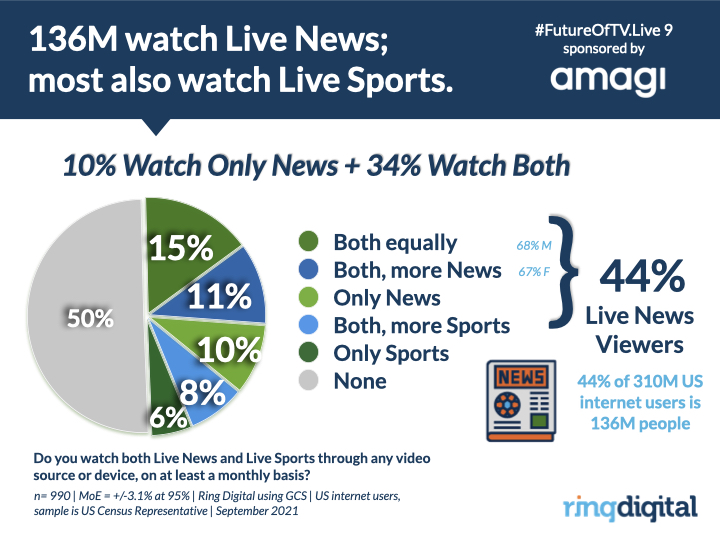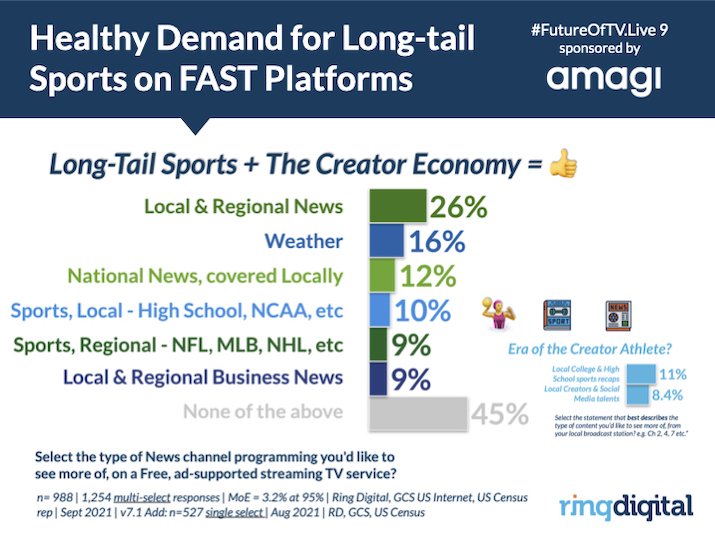Op-Ed: Stations Need Content. Creators Need TV. Long-Tail Sports Can Connect These Dots
Sports is a way for local broadcasters to benefit from 24/7 streaming networks
Story Highlights
An Apple “Think Different” poster of Ted Turner hangs in my home office. Before Ted, TV news was delivered a few times a day by stations covering news, weather, and sports, and major-network affiliates handed that audience to an evening newscast before primetime.
Ted was the first to deliver news on a 24/7/365 basis. Cable News Network became an iconic brand and spawned multiple successful channels within the global pay-TV ecosystem.
Today, local broadcasters have a new set of direct-to-consumer streaming tracks that enable them — for the first time — to provide free 24/7 content without disrupting their national-network commitments to deliver their audiences to primetime network programming.
But filling 24/7 channels with news alone is difficult. Court shows and game shows are great for some of those hours, but, in the streaming era, many other syndicated entertainment shows are available on-demand.
To me, the obvious answer is long-tail sports.
Although many local newscasts have strong talent and well-done sports wrap-ups, they don’t have more than a few minutes in a traditional linear schedule to work with. In the meantime, live–sports-production costs are dropping dramatically at the long-tail, with increasing innovation in gadgets and platforms that make production easy.
 Is there demand for this content? New data from my Fall 2021 #FutureOfTV.Live survey shows two key pieces of data that make me think broadcast-news operations should indeed rethink — and re-ignite — their sports strategies.
Is there demand for this content? New data from my Fall 2021 #FutureOfTV.Live survey shows two key pieces of data that make me think broadcast-news operations should indeed rethink — and re-ignite — their sports strategies.
First, although most analysts tend to look at news and sports as different genres of programming, there’s a huge overlap in audiences who watch both. 34% of U.S. internet users reported that they watch both live news and live sports, with only 6% reporting as sports-only viewers.
Even more promising is that our survey found healthy demand for long-tail sports as well as for local-creator-economy content.
 In two separate polls the study conducted, long-tail sports had a strong showing, beating out professional sports in a question about preferences for news-channel programming on a FAST streaming outlet. (Note, this was not within the margin of error.)
In two separate polls the study conducted, long-tail sports had a strong showing, beating out professional sports in a question about preferences for news-channel programming on a FAST streaming outlet. (Note, this was not within the margin of error.)
Indeed, even as broadcasters nationalize some of their programming across a consolidated–station-ownership footprint, they are well-positioned to launch energized and localized win-wins for their communities — and our country at large.
It sounds pollyanna, but we’re at a time when it seems to me that many massive challenges we face as a society can be positively influenced and shaped by sports.
Indeed, I’m echoing the words of USA Today’s Christine Brennan, who was recently on a Sunday-morning news show providing an update on the horrific USA Gymnastics/FBI crimes: “I wonder if we shouldn’t be looking at these women — at Aly Raisman, Simone Biles, McKayla Maroney, Maggie Nichols … — as people that we can look to as a nation, not just sports. It’s a time for ombuds-people, if they are up to it.”
As I write this, Instagram, a dominant force in sports social media, is facing revelations about how its new-media particulars are harmful to our kids.
Broadcast TV, on the other hand, is a regulated medium and, perhaps as a result, is safer for our kids.
As the RSN model for local sports faces challenges of its own, broadcast stations and local cable channels will find themselves in a similar fix, needing to invest in bold content with their team partners and move into adjacent programming areas to attract local fans.
What role does sports play in our lives and in our society? Whatever it is, filling the enormous capacity of new FAST platforms presents a huge triple-win opportunity — for local stations, long-tail sports, and our country at large.
Brian Ring is principal analyst at Ring Digital LLC, a revenue-growth agency that uses consumer surveys to understand viewing behaviors, inform client product strategies, and execute go-to-market thought leadership for vendors serving TV providers, networks, studios, streamers, and broadcasters around the world.
Sign up at FutureOfTV.Live to receive Ring’s quarterly research and Zoomcast update.
